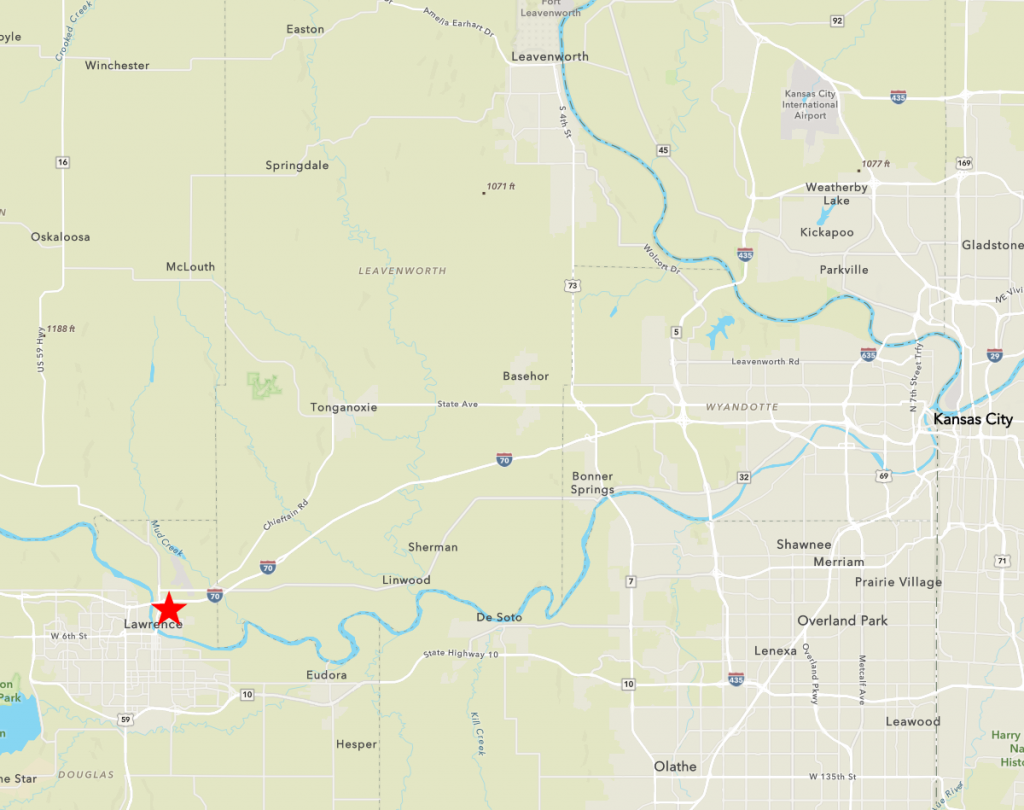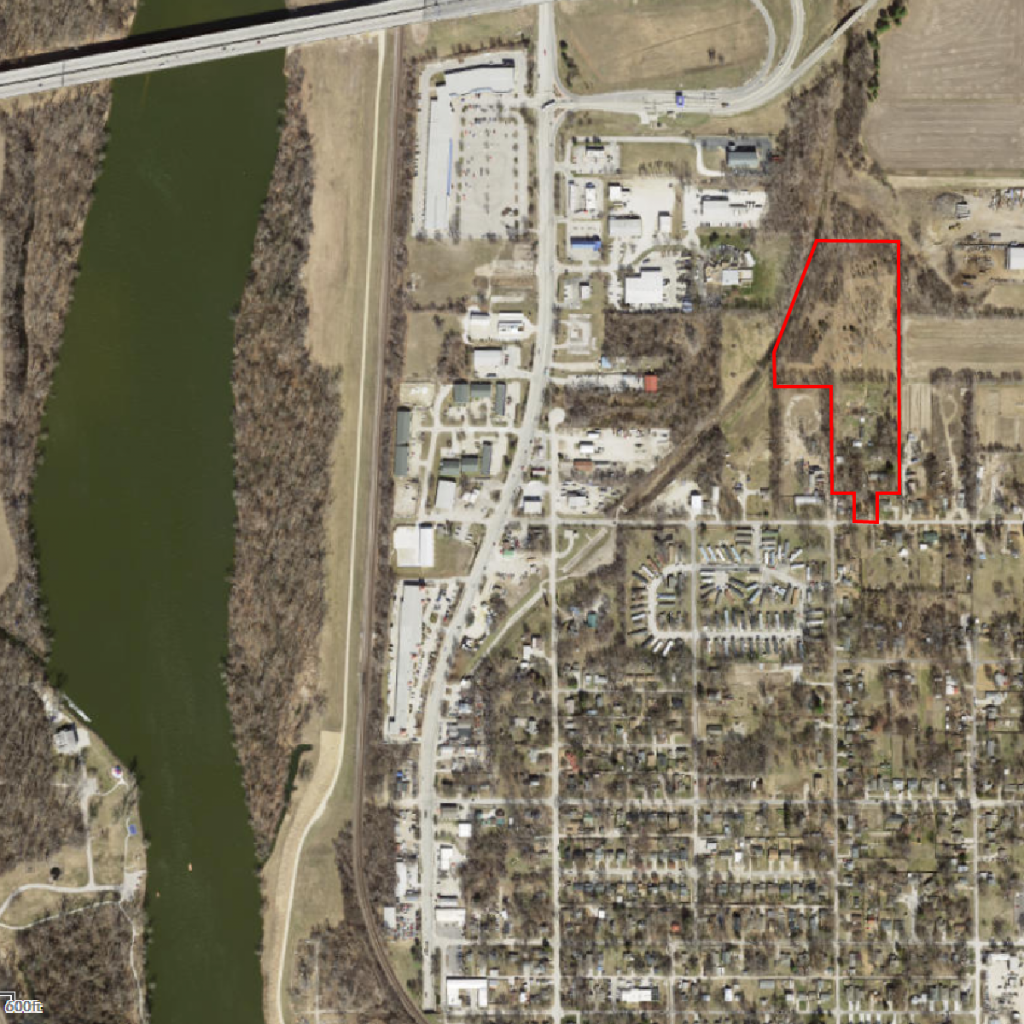
Geographically, Pinwheel Farm lies in a bend of the Kansas River, on the north shore, about 50 miles west of the confluence of the Kansas and Missouri Rivers. The river flows from the northwest, runs less than a mile to the west of the farm, curves about a mile and a half south of the farm as it falls over the Bowersock Dam, and wanders off to the southeast of the farm. The west boundary of the main body of the farm runs 50′ from the centerline of the Maple Grove Tributary, a drainage ditch that carries runoff from far to the north. An unnamed drainage area lies along the north boundary of the farm. The farm comprises 4 separate parcels of real estate.
Geologically, the farm comprises about 12 acres of Eudora silt loam, with invisible drifts of Eudora/Kimo complex (bands of slightly more clay) on the low north pasture. Digging as much as 56″ deep does not reveal any significant difference in soil composition other than the higher organic matter present in surface layers. There are no rocks other than those brought to the farm for decorative purposes. Local lore holds that “you can’t dig enough dirt out of a hole to fill the hole back up” – a testimony to the ceaseless work of tunneling worms, insects and moles to aerate the soil, incorporate nutrients from plant residue, and create an open structure that aids in the drainage. Only under very extended heavy traffic, or if the natural structure is pulverized by mechanical tillage, does soil compaction become a problem.
Hydrologically, water from the Kansas River keeps the water table under the farm at about 20′ below ground level on the south 2/3 of the farm (the high ground). This, combined with the fineness of the soil particles, allows water to be drawn up from lower layers through capillary action. The soil remains moist even in times of drought if surface evaporation is blocked by a heavy mulch of hay or straw. Thus the soil drains quickly but remains moist longer than many soils, enabling extensive vegetable production without reliance on irrigation. A small shallow well supplies high-quality water for the household, livestock, and washing vegetables.

Politically, the farm is in Grant Township, Douglas County, Kansas. The street in front of the farm is essentially the boundary between the North Lawrence neighborhood of Lawrence, Kansas, and rural Douglas County, although properties between the house and the street and to the east of the house have been annexed into the city. When a partner and I purchased the farm ground in 1995, it had been zoned “Light Industrial” since the mid-1960’s. We had it rezoned as “Agricultural” to reflect its historical and intended use, and to emphasize that we have no desire to see it appreciate in monetary value to profit from its sale or development.
Historically, the farm has raised a variety of crops, including peas which were sold to the cannery that once existed in Lawrence. Long-time previous owners were Dale and June Black, who bought the farm in 1950, just before the devastating 1951 flood. Some years ago, Dale and June kept the farm acreage while selling the home site out of the family. Prior to our purchase, the farm ground had been farmed on shares by a local farmer for a number of years in a conventional corn/soybean rotation using chemical fertilizer and herbicides.
Biologically, the farm has made a remarkable change from almost entirely plowed ground in 1996 to a diverse landscape and ecosystem including woodland areas (the “Wilderness”), a native grassland area developed under the USDA’s Conservation Reserve (CRP) Riparian Protection Program, silvopasture, and garden areas. An incomplete census of exclusively wild and naturalized species (not deliberately brought to the farm by human activities) about in 2000 identified nearly 500 different life forms identifiable to the level of genus and species; many more species have been identified since then. A complete census over a year’s time could realistically reveal over a thousand different species visible to the naked eye. We see significant new visitors/residents every year. Some of the original CRP trees–walnuts, pecans, and burr oaks–have seeded themselves.
Socially and educationally, the farm has played a part in the lives of many people of all ages, circumstances, and abilities. Food, of course, has been the focus of many social activities. In addition to the farm’s own market gardening, “community gardeners” have shared the growing space from time to time. Sheep shearing, tree planting, egg dying, and farm tours have provided educational and social opportunities for people of all ages. Home school groups, Girl Scout troops, kindergarten classes, and special education classes have all arranged tours of the farm. Pinwheel Farm partnered with a small private school to offer a half-day intensive participatory “Farm School” program to its young teenagers for several years, and has operated an after-school day care program for grade school children. Our educational programs are constantly evolving to meet the interests of our community.
Spiritually, the farm has been a place of rest, reflection, and renewal for many who have lived or visited there. In fostering spiritual community, the farm has hosted a wedding, Easter sunrise services, and meditation walks.
Personally, Pinwheel Farm has nourished all of me: mind, body and spirit. It has taught me invaluable (though often hard) lessons, and fostered incredible personal growth. More than anything else, the farm has given me an abiding and deep faith in the goodness, wisdom, and almighty power of a loving Power greater than myself–a creating, redeeming and sustaining God who is with me every step of the way. I have only to open my eyes to God’s presence, humbly ask for help, and accept what I am so abundantly given.
In bringing me to Pinwheel Farm and giving me the guidance, resources and vision to develop it, God gave me a sobering responsibility indeed: to be a wise steward of these 12 acres, not for short term profit but to begin here to build God’s Kingdom on Earth. I accept it as a commission akin to Noah’s: to build the environmental and human equivalent of a ship in the desert and to welcome aboard a diverse cross-section of members of God’s Creation – a Community of Life, both human and non-human. Together, perhaps, we can cultivate, share, and preserve our collective wisdom in a refuge at least a little sheltered from the flood of a dominant culture and way of life that threatens to usurp the role of God and overrun all of creation in its rat-race quest for more, bigger, faster, and “better.” In troubled times – whether from economic downturn, natural disaster or other – we hope to be a stabilizing influence in our community, teaching people hands-on skills to better their situations.